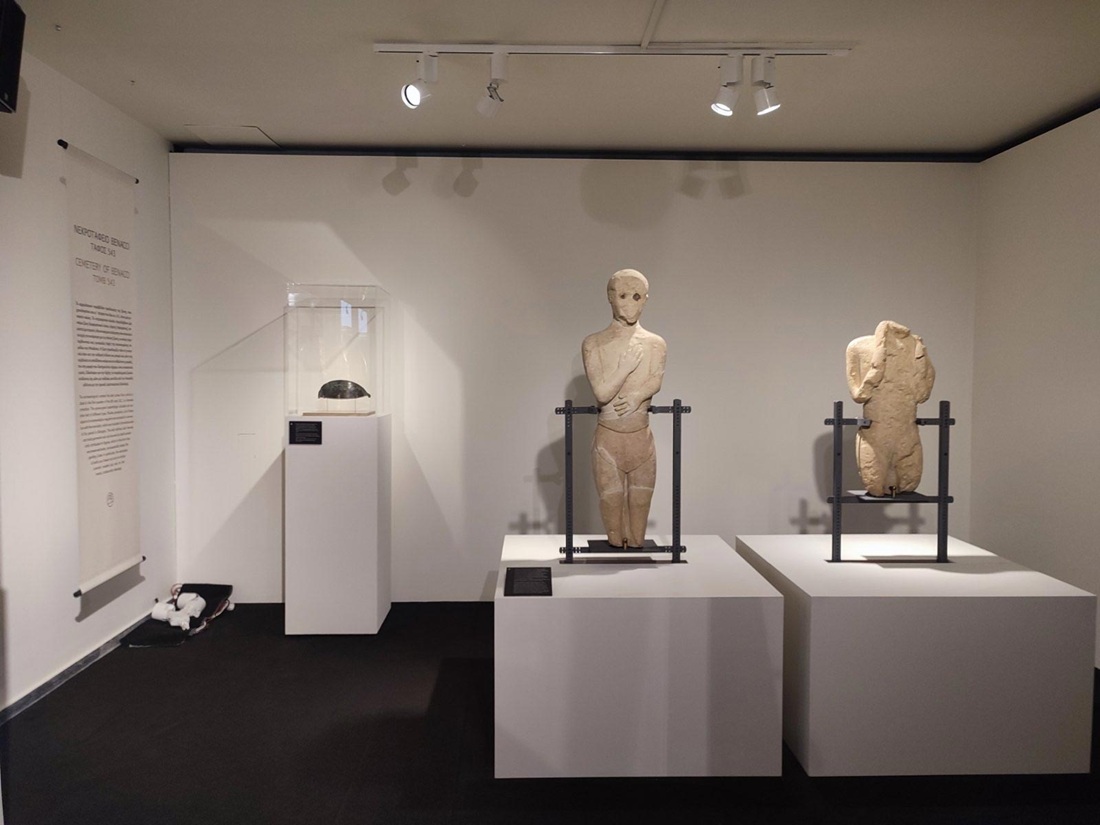
The present article is written by Professor Nikolaos Chr. Stampolidis
How to fit forty (40) years of excavations, forty years of life and activity in a few pages? How to enclose the people, workers, students, scientists –archaeologists, architects, anthropologists, epigraphists, palaeobotanists, zooarchaeologists, historians– and others, supporters of the entire project, sponsors and donors with sensitivity to archaeology, history, civilization, a civilization revolving around the human being… the human being as living entity with sense and sensibility, changing in the course of time.
What of all this can the showcases -old and new ones- contain? Which memories should I retrieve from the oblivion of years, which should I choose first, which should I mention?
The fact that when we started excavating, on 8 September 1985, a single bus was coming once a week to serve the two neighbouring villages, Eleutherna, former Anachourdometocha, and Ancient Eleutherna, former Prines? The winding road that starting from Rethymnon ascended passing by a series of villages, of Viran Episcopi towards Erphous and Skoulouphia, and it was just two years after the beginning of the excavations, in 1987, that Vaso Mosialou took care for a new road to be constructed, which through Viran (in Ruins) Episcopi, came to the junction with the Monastery of Arkadi to cross through Eleutherna? The sofa I first slept on, the garden hose which we used for washing our hair in the garden of the houses we stayed in? The problems that the differences between the Communities caused early on? The initial distrust towards the project and the abilities of the ‘university people’?
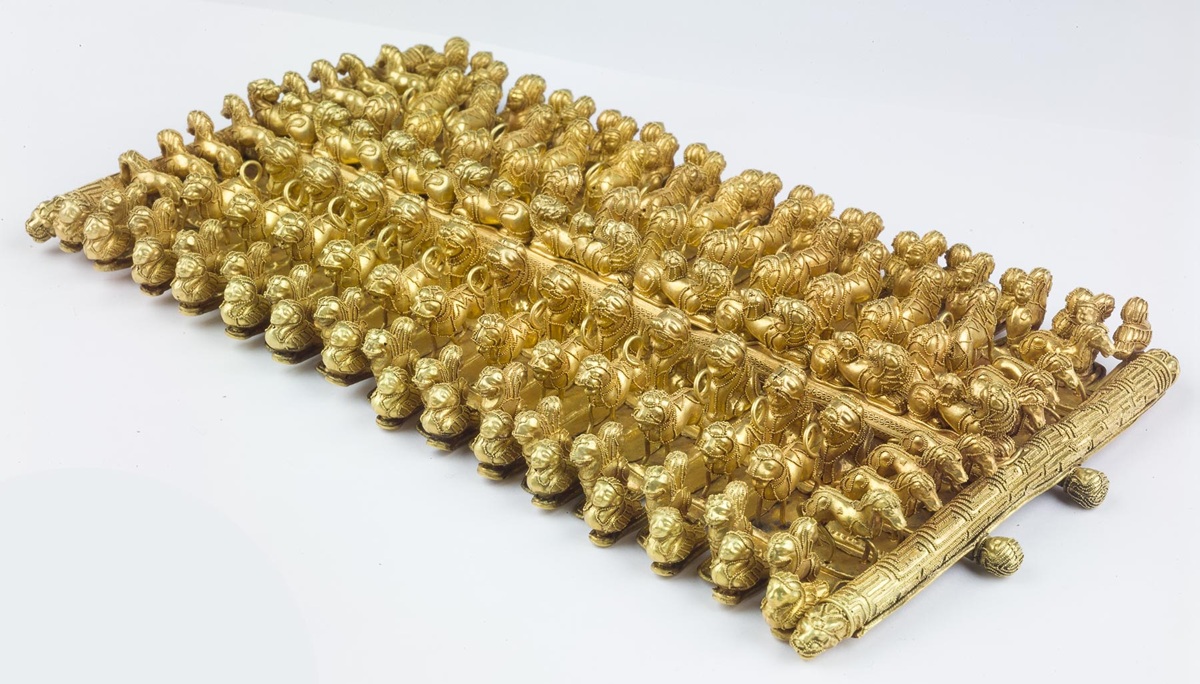
Gold plaque, decorated with rows of animals, both realistic and mythical. Early second quarter of the 7th century BC. Bernardini Tomb. Rome, National Etruscan Museum of Villa Giulia, inv. no. 61545. © Museo Nazionale Etrusco di Villa Giulia / Mauro Benedetti.
And yet we did put down roots there in spite of the initial difficulties, thanks to the smile and hospitality of the majority of the inhabitants of both villages who embraced all of the project works and advanced with us towards a dynamic future for their children and the children of their children. We deemed Archaeology not as interpretation of the past, but as inspiration of the present that is constantly building a better future through memory, knowledge and collective activity: we viewed Archaeology as a public good.
Thus, the aged population and the flight of young people came gradually to an end, their return is by now certain, the weathered by the passage of time houses were renovated and are being renovated, life thrived again with reason and knowledge in the archaic landscape that encircles the villages and radiates across the surrounding areas of the municipalities of Rethymno and Mylopotamos. But above all, their faith in their land was revived and the consciousness of their identity, through the history of Eleutherna, that makes them proud with no excess, because they understand that the excessive spoils the stable and that the balance of nature and humans is the desirable goal.
And we will continue to head in that direction, in spite of whichever adversities, ‘Laistrigonians, Cyclops, angry Poseidon’… (of bureaucracy) don’t be afraid of them’, ‘as long as you keep your thoughts raised high, as long as a rare excitement stirs your spirit and your body’. I recall Angelos Delivorias reminding me: “duration, Nikos, patience, perseverance, duration and continuity, these are all that matter, these are Greece»”. These are Greece, these are Crete, this is Eleutherna which, from an un-known place, was put on the universal archaeological map and there it features not as a simple dot, but as destination, setting an inspiring example, as long as you deeply believe in it and serve it with consistency and commitment, with collaboration and -the hardest- with the participation of society.
The contribution of the local community to the understanding and preservation of archaeological sites and in general every cultural site, the great demand in a world that is faltering between economic crises, pandemics and wars, in Eleutherna became a reality. What if it took 40 years? I am grateful that Time, with a capital T, allows me to continue with the same faith, that is, in fact, not to sin, because sin is to miss your goal, to go astray.
So, on this same road, on this path, just as last year we united ‘Picasso with the Joy of Life’ with the antiquities and ancient Eleutherna, this year, to celebrate 40 years since the beginning of excavation research in the necropolis of Orthi Petra, we created an Exhibition, a celebration of real Archaeology.
We thought: What was it that made Eleutherna stand out and not remain a dot on the archaeological map, but to become a destination? The necropolis of Orthi Petra, the cremations and burials of princes (in the broad sense of the term), warriors and princesses – priestesses, men and women respectively. In other words, a place of silence, like the necropolis, which speaks eloquently of the lives of the people of antiquity, of their truth, that rises from the earth and merges with the poetry of Homer, which illustrates his verses.
And again: Does this truth stand alone? Where are the neighbouring and other cities, the more distant horizons? Where does Eleutherna of the Geometric-Archaic times stand in the ancient land and sea routes of the Mediterranean, this sea between three continents? Europe, Asia and Africa?
That is why we chose to celebrate forty years of our excavation research by inviting guests – ancient and current – not only from Crete but also from Cyprus, Magna Graecia and Etruria, the Iberian Peninsula. Artefacts of life in antiquity from 18 Museums of today, arks of Culture, have been gathered in this Exhibition to unite the line that defines the Mediterranean space from East to West and of course Time from then to now.
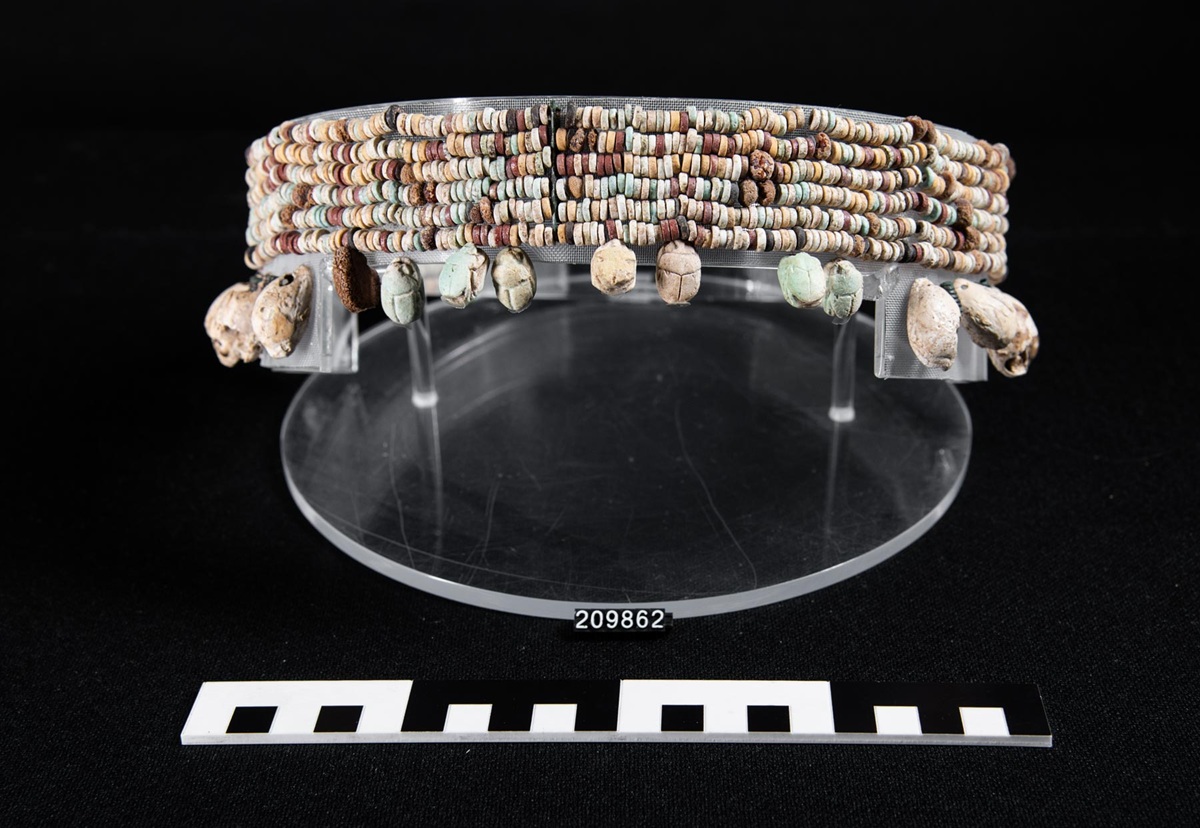
Diadem consisting of six rows of beads made of faience, amber, bone, bronze pendants, shells (cowries), and faience scarabs. Approximately early 7th century BC. Cazzaiola site, Tomb 315. Policoro, National Museum of Siritide, inv. no. 209862. © Archivio Museo Nazionale della Siritide.
Around 130 ancient works from Cyprus, Italy and Spain come together and converse with more than 400 other finds from Eleutherna, creating companionships in new and old showcases. Works of stone and on stone, of clay, of gold, silver, bronze and iron, of faience, glass and ivory, ostrich eggs, semi-precious stones, amber, amethyst, carnelian, ore crystal, Egyptian blue… Objects of body adornment and headgear, pectoral and hand jewellery: diadems, hair combs, earrings, pendants and necklaces, bracelets, wristbands, fibulae and brooches, rings and belts…
Defensive weapons for the protection of the head, body, arms, legs: helmets, armour, armbands, armbands, molds, greaves, shields… Offensive weapons, spearheads, swords, daggers, arrows… Objects of use: terracotta vases and bronze vessels for food and drink, luxurious or for daily use, but also for other uses, vessels for bathing, cleaning, urns, cauldrons, kraters, oenochoes and cups, phiale, fruit vessels, basins or plates… and also spit-stands and spits, soup ladles, cheese, graters, flasks…
But also aromatic and medicinal vessels, to perfume the body, to soothe or cure human pain: lekythoi and lekythia, alabastra, aryballoi, vials…
Terracotta figurines, faience, bronze, inscriptions…
But what does all this represent? Why all of this?
The cheese grater, the tyroknistida, which Homer mentions, in order for the heroes to grate the cheese inside the wine, what does it have to do with the lioness-shaped handle that Aristophanes mentions centuries later? Meaning, that in order to stop the war, the women of Athens vowed not only not to make love to their husbands, but also not to use these wooden handles to satisfy themselves!
What story can be told by the soup ladles, bronze or silver, whose handles bend outwards according to the Greek type or inwards according to the Cypriot type? And what does it mean when one of these latter ladles is found in Palaipafos, Cyprus, and a similar one in the triple pithos-burials of Eleutherna? Moreover, when the latter is even found excavated together with Cypriot Late Geometric oenochoe? Is it the dowry that one of the tomb’s occupants brought with her when she came as a bride for an Eleutherna warrior, and all of her trousseau was later placed as grave goods in her last residence? And how is she related to the other prestigious females of the pithos-burials who share genetic characteristics according to anthropologists? Is she the original ancestor of the others who took meaningful traits from her DNA?
And then again, what can be told about the dissemination of eating habits by the spit-stands, the supports on which the the metal spits to pass portions of cut meat (souvlakia) were placed, which start from burial finds in Cyprus and are also found in Eleutherna and Knossos up to the rich Etruscan tombs of central and northern Italy?
Or, what relationship can a metal vase stand of an Etruscan tomb, on the hooks of which the wine drinking vessels were hung from the handles, indicate in relation to Eleutherna, where no similar objects have been found to date? However, at the end of the Etruscan vase-stand, the heads of helmeted young warriors are depicted as “talking symbols”, indicating who used the vase-stand. And, naturally, the lightning logical stride leads us to the archaic inscription from Eleutherna, where the prohibitory injunction is written: “Μη ινπίνειν δρομέα”, meaning the runners, the young warriors – heralds and couriers – were forbidden to drink and get drunk so that if they were captured they would not betray the secrets of their mission.
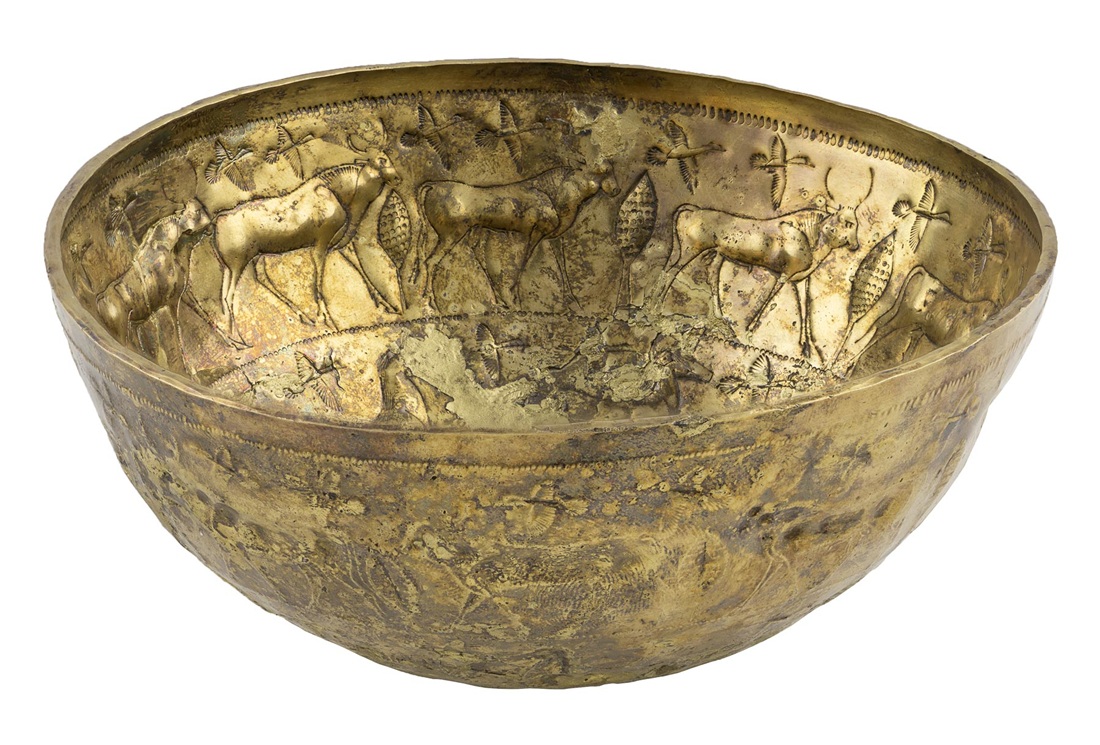
Gilded silver “Phoenician” flask (ritual vessel). Early second quarter of the 7th century BC. Bernardini Tomb. Rome, National Etruscan Museum of Villa Giulia, inv. no. 61543. © Museo Nazionale Etrusco di Villa Giulia / Mauro Benedetti.
I will not speak here more about multiple stories and examples of acts and commercial exchanges and also ideological, political or other transmissions about the identical necklaces of gold and ore crystal of a princess from Salamis in Cyprus and a princess from Eleutherna, or the inscription of the “World of Strangers” from Eleutherna, that is, the official who dealt with foreigners who came to ancient Eleutherna, to live or to be protected, indicating a society with open horizons. Nor does space permit me here to refer to other stories, such as can be extracted from the material remains of Geometric and Archaic period societies from Cyprus, Crete, and the Italian and Iberian peninsulas!
Nor will I insist here on the confirmation of Homer’s truth, as the poet describes the ritual of the funeral pyre of Patroclus in the 23rd Rhapsody of the Iliad in relation to a finding of the funeral pyre of the prince-warrior with the captive from the necropolis of Orthi Petra in Eleutherna. These moments, that is, where epic memory is essentially illustrated by the material remains of an event in the funerary practice of the necropolis of Eleutherna and which is connected with the rules of the law of war, the customs and traditions of the time…
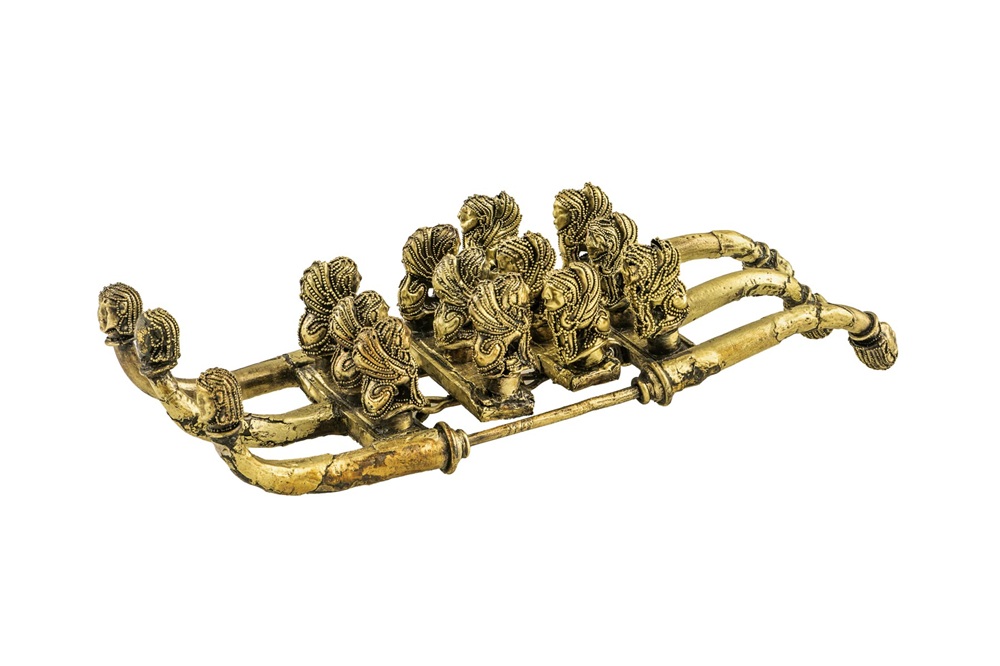
Gold ribbed buckle (fibula). It is decorated with four triads of seated sphinxes as well as six female figures. Early second quarter of the 7th century BC. Bernardini Tomb. Rome, National Etruscan Museum of Villa Giulia, inv. no. 61567. © Museo Nazionale Etrusco di Villa Giulia / Mauro Benedetti.
Without any exceptions, all the ‘visitors’ participating in the Exhibition, from one end of the Mediterranean to the other, the artefacts from the rich tomb 247 of Palaepafos in Cyprus and the warrior’s context from Basilicata in southern Italy, the exceptional grave goods from the tombs of south and north Italy, the objects from the Archaeological Museum of Madrid, all together and each one separately have unique human stories to tell. However, the works involved from the tombs of the Queen of Picene, from the Sirolo Numana, considered a ‘witch’, those from the circle of Aquastrini and the gold and bronze objects from the Regolini-Galassi tomb of the Vatican Museums really impress, not only the eyes of the students but also of all visitors to the Museum of ancient Eleutherna. But the Bernardini tomb context from the Villa Giulia in Rome with its dozens of gold, silver, bronze and ivory grave offerings traveling abroad for the first and last time, demonstrates a world of first-rate princely living, a world of wealth and contacts that, together with all the works in the Exhibition, including the burial offerings of cremations and burials from the necropolis of Orthi Petra in ancient Eleutherna, take us on a journey to the Mediterranean world of the “Homeric” narratives in a way that remains indelibly imprinted in memory.
The Exhibition “Archaic elites. Warriors and princesses” unravels not only lines of technological or aesthetic civilization, but lines of history and mainly human lines. It speaks of relationships, journeys, intermarriages, conjugations, diffusions, and human joys and sorrows, in a web of roads, movements and connections, in a Mediterranean pulsating with human lives. Every object, small or large, humble or rich, is a thread around a spindle whorl and a spindle rod, where the web of Penelope and the cloth of a noblewoman are woven, where memory is present even through the shreds of Time, what people, time and Nature have handed us not only to preserve, but above all to continue the thread of history through daily act that functions but above all that moves.
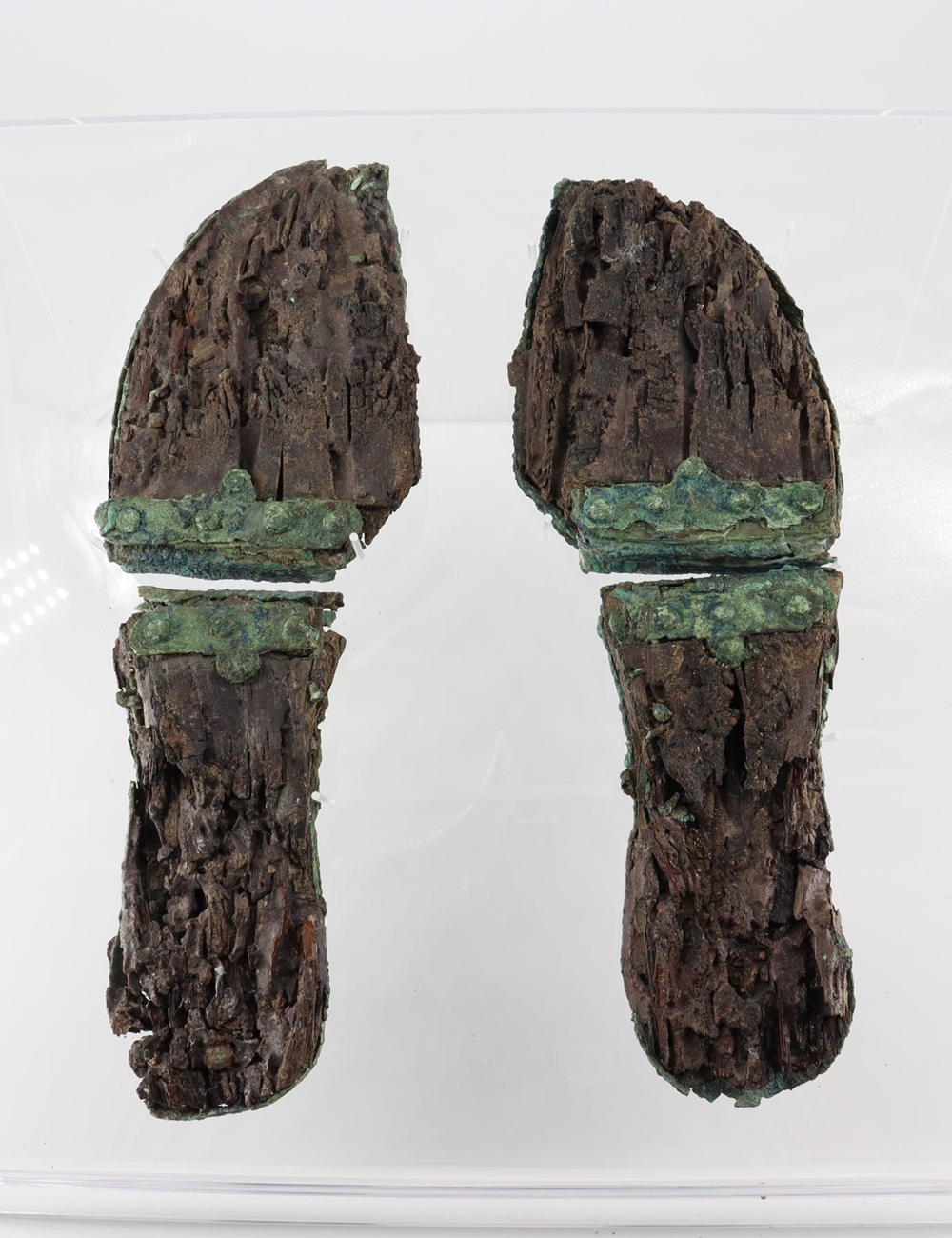
Pair of footwear (sandals) with soles made of bronze sheet and wooden base. 6th century BC. “Tomb of the Queen.” Ancona, National Archaeological Museum of Marche, inv. no. 65749. © Palazzo ducale di Urbino – Direzione regionale Musei nazionali Marche – Ministero della Cultura.
My heartfelt thanks to everyone without exception, my colleagues and students, the Ministry of Culture, the University of Crete, the Friends of the Museum of ancient Eleutherna, and of course the sponsors of the Exhibition listed below, without whose assistance, appreciation and love, nothing could have been transformed from thought and vision to action.
I will have the opportunity to inform you soon regarding the development of the sites of the ancient city and the great basilicas, the planned works in the eastern part of the site of ancient Eleutherna in order to make it a destination for religious tourism.

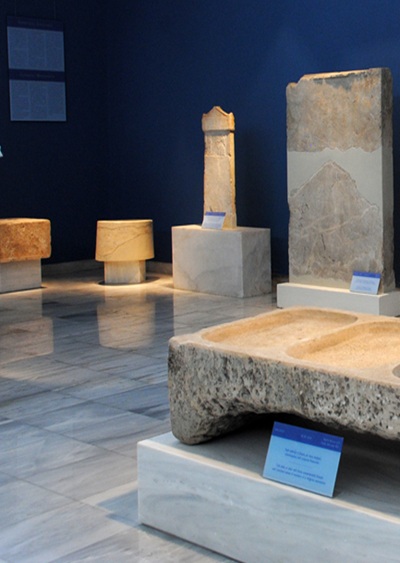
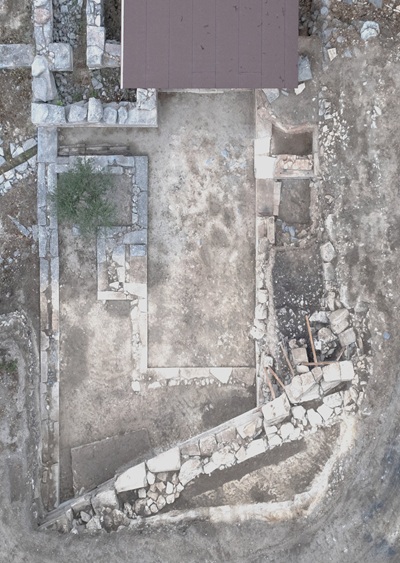
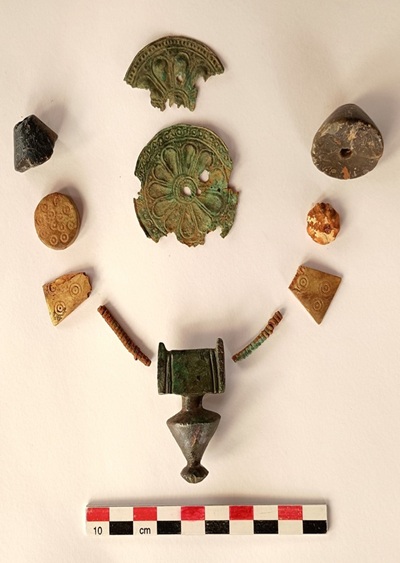
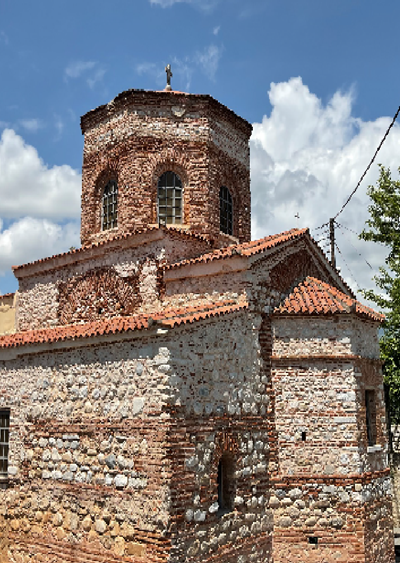


Leave A Comment